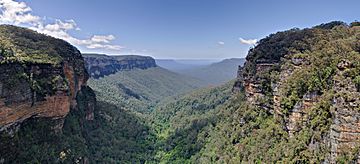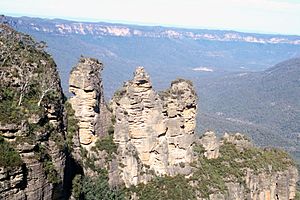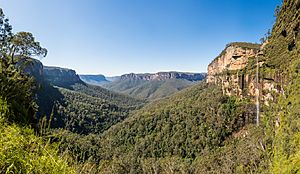Greater Blue Mountains Area facts for kids
| UNESCO World Heritage Site | |
|---|---|

A view over Jamison Valley, in 2008.
|
|
| Location | New South Wales, Australia |
| Criteria | Natural: (ix), (x) |
| Inscription | 2000 (24th Session) |
| Area | 1,032,649 ha (2,551,730 acres) |
| Buffer zone | 86,200 ha (213,000 acres) |
The Greater Blue Mountains Area is a special place in New South Wales, Australia. It is a World Heritage Site, which means it's important for everyone on Earth. This area was added to the World Heritage List in November 2000.
Contents
Discovering the Blue Mountains
This amazing area has rugged flat-topped mountains, tall cliffs, deep valleys, and winding rivers. It is home to many rare and unique plants and animals. They help tell the long story of Australia's natural history. This place also shows how Australia's special eucalypt trees and other living things have changed over time.
The Greater Blue Mountains Area covers about 10,300 square kilometres. That's a huge space! It's mostly forest on a sandstone plateau. This area is about 60 to 180 kilometres inland from central Sydney. It includes large areas of wild nature. The size is like one-third of Belgium.
The Blue Mountains often look blue from a distance. This happens because the air gets warmer. When it does, tiny bits of oil from the eucalypt trees float into the air. These tiny oil particles scatter blue light, making the mountains appear bluish.
The World Heritage Site includes eight protected areas. These areas are split into two main parts. They are separated by land used for roads and homes. The protected areas are:
- Jenolan Caves Karst Conservation Reserve
- Blue Mountains National Park
- Wollemi National Park
- Yengo National Park
- Nattai National Park
- Kanangra-Boyd National Park
- Gardens of Stone National Park
- Thirlmere Lakes National Park
The Blue Mountains are not really tall, pointy mountains. Instead, they are a sandstone plateau. This flat area rises from less than 100 metres above sea level to 1300 metres at its highest point. Deep valleys cut through this plateau. There are also areas of basalt rock on the higher ridges. Many different plants and animals live here. They likely survived big climate changes in the past by finding safe places to hide.
Amazing Plants of the Blue Mountains
This area is famous for its many different types of eucalypt homes, called habitats. You can find wet and dry forests, grassy areas, and even swamps. There are 91 different kinds of eucalypts here. This is about 13% of all the eucalypts in the world! Twelve of these kinds only grow in the Greater Blue Mountains Area.
Scientists see this area as a natural laboratory. It's a great place to study how eucalypts have changed over time. Because so many different types grow here, it shows how they have adapted to Australia's different environments. You can see tall forests, open woodlands, and even small, bushy trees on the exposed plateaus.
The Greater Blue Mountains Area also has very old, rare plants. These are like "living fossils." The most famous one is the Wollemi pine. This tree dates back to the time of the dinosaurs. People thought it was extinct for millions of years. But a few of these ancient trees were found in three small groups. They are hidden in remote valleys within this area. The Wollemi pine is one of the rarest plants on Earth.
Types of Plants
- Sclerophyll: These plants have very tough leaves and stems. They often contain poisons or things that are hard to digest. This helps protect them from animals that eat plants, called herbivores. In Australia, these are often dry grasslands with eucalypt and Acacia trees.
- Mallee: This is a type of plant growth. Mallee plants are groups of small trees. They grow from an underground lignotuber. This is a starchy, enlarged root or stem that stores water. It makes clumps of smaller eucalypt trees.
Animals of the Blue Mountains
More than 400 different kinds of animals live in the valleys and on the plateaus of the Greater Blue Mountains Area. Some of these are threatened or rare. These include the tiger quoll, the koala, the yellow-bellied glider, and the long-nosed potoroo. There are also rare reptiles and amphibians. Examples are the green and golden bell frog and the Blue Mountains water skink.
The biggest hunter in the area is the dingo. These wild dogs hunt for animals like grey kangaroos.
The Greater Blue Mountains Area is also an Important Bird Area (IBA). This means it's a very important place for birds. It has many rockwarblers, flame robins, diamond firetails, and pilotbirds. The endangered regent honeyeater is often seen here. It is also a key stop for yellow-faced honeyeaters during their migration.
Why it's a World Heritage Site
The Greater Blue Mountains Area became a World Heritage Area on November 29, 2000. It was the fourth area in New South Wales to get this special listing.
This site was chosen for the World Heritage list for important reasons:
- Unique Eucalypts: Australia's eucalypt plants are very special. They have adapted and changed over millions of years, especially after Australia separated from other continents. This area has many different eucalypt habitats. These include wet and dry forests, grassy areas, swamps, and wetlands. There are 90 different kinds of eucalypts here, which is 13% of all eucalypts worldwide.
- Rare and Ancient Plants: The area has many plants that are found nowhere else. There are 114 types of plants that only grow here. Also, 120 plant types are rare or threatened in Australia. The site is also home to very old plant species, like the Wollemi pine. These plants have survived in small, protected spots for a very long time.
Related pages
Images for kids
-
Three Sisters, Blue Mountains National Park
-
Kanangra Walls at Kanangra-Boyd National Park
-
A dingo at Yengo National Park
-
Red-necked wallaby in the Blue Mountains
See also
 In Spanish: Región de las Montañas Azules para niños
In Spanish: Región de las Montañas Azules para niños













